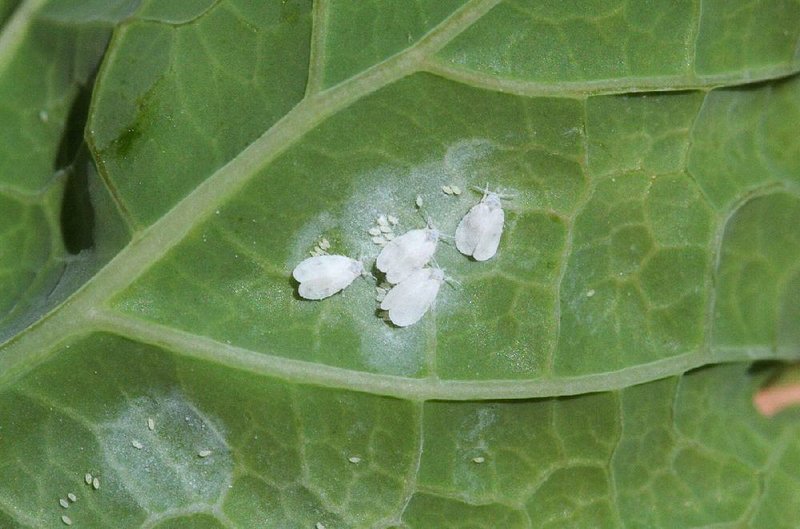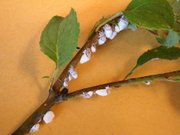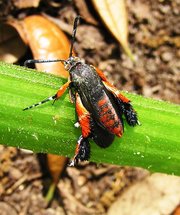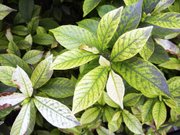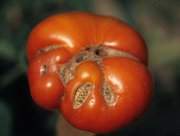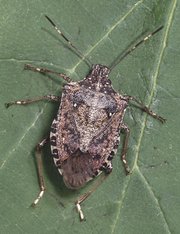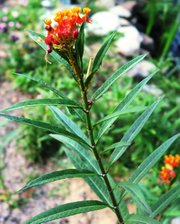A mild winter, coupled with a mild spring and plenty of rain, gave us a bouquet of flowers in our gardens, great vegetables and plenty of bugs.
Insects of all kinds seem to be around in abundance this season, so scout your garden often and take them out before they take over.
APHIDS
Aphids are the rabbits of the insect world, giving birth to living young and spreading quickly.
Aphids can feed on one of the widest ranges of host plants of any insect -- from flowers and vegetables to shrubs and trees. Aphids are equal opportunity feeders.
The tiny, pear-shaped, soft-bodied insects can be green, brown, white, black, yellow or pink.
Adult and nymph stages feed on plants, sucking sap and exuding a sweet substance called honeydew. Honeydew can fall on leaves and stems, or on car windows or patio furniture, and create a sticky residue. If the residue stays on the surface long enough, black sooty mold forms, and that can cover a plant, reducing photosynthesis.
Aphids have a piercing, sucking mouthpart, and their attack is similar to sticking a small straw into the plant's stem and sucking out its juices. While they can feed on any plant parts, they prefer the tender, new growth.
Aphids are not difficult to kill, but they tend to get out of hand quickly if you don't watch for them. Often they cluster together as they feed. A spray of water can knock down a small group, or you can use insecticides, including insecticidal soap.
If you have ladybug beetles around, let them do the job. They love to feast on aphids.
WHITEFLIES
Whiteflies are soft-bodied, winged insects closely related to aphids and scales, and they also feed by sucking sap from plants. They attack a wide variety of plants, from ornamentals to edibles, but gardenias are one of their favorite hosts.
They typically feed on the undersurface of the leaves and lay their eggs there as well. Each female can lay 400-500 eggs in a cluster, so you can imagine how quickly they multiply.
The adults are small, usually less than half an inch long. They have four broad, delicate wings that are held rooflike over the body and are covered with white powdery wax.
Whiteflies are active during the day when it's warm, all clustered together on the underside of leaves. If you disturb a plant with an infestation of whiteflies, you'll see what looks like floating dandruff.
They can be challenging to control. Contact insecticides like insecticidal soap can work, but they must touch the insect, which is typically on the bottom of the leaves.
Whiteflies are attracted to the color yellow, so you can make a yellow sticky trap to catch them. Take a 12-by-6-inch strip of cardboard or strong poster board. Paint both sides bright yellow and coat them with a sticky substance, such as Tanglefoot, petroleum jelly, mineral oil or a mixture of petroleum jelly and mineral oil. Hang the trap vertically or support it on stakes just above the plants. The adults are attracted to the yellow and become trapped on the sticky substance.
Whitefly traps also are available commercially.
SCALE
Another common pest with a piercing/sucking mouthpart is scale. These insects are related to aphids and whiteflies, and there's a wide range of insects in the scale family. They attack a wide range of ornamentals, including the crape myrtle, and they are very common on golden euonymus, camellias and hollies.
They are generally divided into two categories, soft scales and armored or hard scales.
Soft scales produce a soft, thin covering that can be cottony, powdery or waxy in nature.
This layer covers the insect and cannot be separated from the insect's body. Soft scales often produce copious amounts of sweet honeydew, resulting in black sooty mold forming on leaves and trunks of infested plants.
Armored scales have a hard, shieldlike cover that conceals the body but is not attached to it. This hard shell is composed of shed skins and wax.
Scale insects attach themselves to plants using their piercing-sucking mouthparts and feed on sap. Once they attach themselves, they don't move. Individual scales may look like oval or rod-shaped bumps, ranging in color from white, yellow, gray, brown to black.
These insects can be a major problem on many shrubs and trees. Heavy infestations of scale can cause yellow or mottled foliage and premature leaf drop.
In the case of crape myrtle felt scale, they also decrease the number of flowers.
Scale insects rarely kill a plant, but a plant weakened by scale is often more susceptible to damage by other insects or diseases that may ultimately kill the plant.
STINK BUGS
The stink bug is another insect pest that feeds on a wide range of plants, including fruits, vegetables and ornamentals. Stink bugs range in color from brown to brilliant green, although many have a dull shade designed to blend in with the plants they infest.
Nearly all species are distinguished by a triangle- or shield-shaped plate on their backs.
Stink bugs are part of an order of insects sometimes called "true bugs," which do not chew with their mouths; instead, they have a piercing/sucking mouthpart that allows them to suck the sap of whatever they are feeding on.
They create multiple generations per year. Females typically lay eggs in a cluster on the surface of the leaf. (The related squash bug lays the eggs on the undersurface of the leaf.) The eggs hatch in about a week, and the nymphs look like tiny adults. They take about four weeks to reach maturity.
At night, they are attracted to light and therefore can sometimes be seen flying around outdoor lights. Often they can be seen hanging around their favorite host plants, especially tomatoes, melons and beans. When they feed on tomatoes and peaches, they create ugly scars called "catfacing."
Stink bugs can be difficult to control because they are resistant to some insecticides, and the later in the season it is, the tougher they are to kill. Scout your garden, and if you see the egg clusters, rub them off.
You can trap the adults by placing melon rinds in the garden overnight. The insects will congregate under them to feed, and you can dispose of them in the morning.
Be aware that they are aptly named. When disturbed or killed they give off a noxious odor.
SQUASH VINE BORER
Squash vine borer is a serious pest problem on members of the cucurbit family, with summer and winter squash and pumpkins the most commonly attacked. It is less of a problem on melons or cucumbers.
The adult is a clearwing moth, which looks somewhat like a wasp. It is about half an inch long with an orange abdomen with black dots. Adults emerge in June from cocoons in which they overwintered in the ground.
The wasplike moths are unusual in that they fly during the day, while most moths fly at night.
The female adult lays eggs near stems at the soil line. Eggs are small, flat, and brown, not readily visible. The larvae hatch in about a week and begin to tunnel into the stem to feed. They are white- or cream-colored with brown heads, and they will eventually grow to almost an inch in length. As they feed they block the flow of water to the rest of the plant, and the tops of the plants collapse.
If you can prevent them from entering the stems by wrapping a small piece of aluminum foil lightly around the stem, or if you can catch them as they enter and kill them, the plants can be saved.
The larvae feed for four to six weeks and then burrow back into the ground to pupate and spend the winter, where they stay until the next season. Thankfully, there is only one generation per year, and so late-planted squash is not affected.
There are almost 30 million species of insects in the world, including some we couldn't live without. But some we would rather not have in our lives. The key to success in the garden is regular scouting. The sooner you can catch a problem and identify it, the sooner you can begin to control it.
If you aren't sure whether a troubled plant is infested with insects or has a disease, or you aren't sure what insect is causing the problem, take a sample to your local county extension office for a correct diagnosis. University of Arkansas Cooperative Extension Service offices are listed in phone books and at uaex.edu.
Janet B. Carson is a horticulture specialist for the University of Arkansas Cooperative Extension Service.
HomeStyle on 06/18/2016

